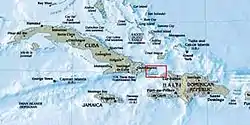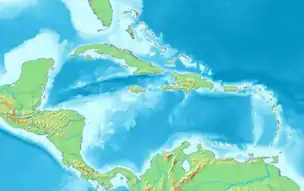Windward Passage
The Windward Passage (French: Passage au Vent; Spanish: Paso de los Vientos) is a strait in the Caribbean Sea, between the islands of Cuba and Hispaniola. The strait specifically lies between the easternmost region of Cuba and the northwest of Haiti.[1] 80 km (50 mi) wide, the Windward Passage has a threshold depth of 1,700 m (5,600 ft).
| Windward Passage | |
|---|---|
 The Windward Passage marked in red. | |
 Windward Passage  Windward Passage  Windward Passage | |
| Coordinates | 20°N 74°W |
| Basin countries | Cuba Haiti |
| Max. width | 80 kilometres (50 mi) |
| Average depth | 1,700 metres (5,600 ft) |
With Navassa Island on its southern approach, it connects the Atlantic Ocean to the Caribbean Sea, and is in the direct path of shipping between the Panama Canal and the eastern seaboard of the United States.[1]
From either the eastern tip of the Guantánamo Province of Cuba, or the western tip of Haiti's Nord-Ouest Department, it is possible to see lights on the other side of the Windward Passage.[2]
Territorial Dispute
For decades, Cuba and Haiti had disputes over where the maritime boundary between the two nations was. In 1977, they settled by signing the Cuba–Haiti Maritime Boundary Agreement setting the official boundary.
Geology
The Septentrional-Oriente fault zone passes through the Windward Passage from the southern coast of Cuba to the northern coast of Hispaniola. During the Holocene the slip rate between these two islands was 9 ± 3 mm (0.35 ± 0.12 in)/year. The Septentrional Fault extends east at least to the still active Mona Rift in the Mona Passage, where extension occurs between Hispaniola and Puerto Rico.[3]
See also
- Leeward Passage – A channel between Hans Lollik Island and northern St. Thomas Island in the United States Virgin Islands
References
- Riley, Shannon Rose (2006). Imagi-Nations in black and white: Cuba, Haiti, and the performance of difference in United States national projects, 1898–1940 (Thesis). University of California, Davis. p. 50. OCLC 191680434. Archived from the original on March 23, 2012.
- Lapidus, Benjamin L. "Stirring the Ajiaco: Changüí, Son, and the Haitian Connection." In Cuban Counterpoints: The Legacy of Fernando Ortiz, edited by Mauricio A. Font and Alfonso W. Quiroz, 237-45. Lanham: Lexington Books, 2005.
- Symithe, S.; Calais, E.; Chabalier, J. B.; Robertson, R.; Higgins, M. (2015). "Current block motions and strain accumulation on active faults in the Caribbean". Journal of Geophysical Research: Solid Earth. 120 (5): 3748–3774. Bibcode:2015JGRB..120.3748S. doi:10.1002/2014JB011779.